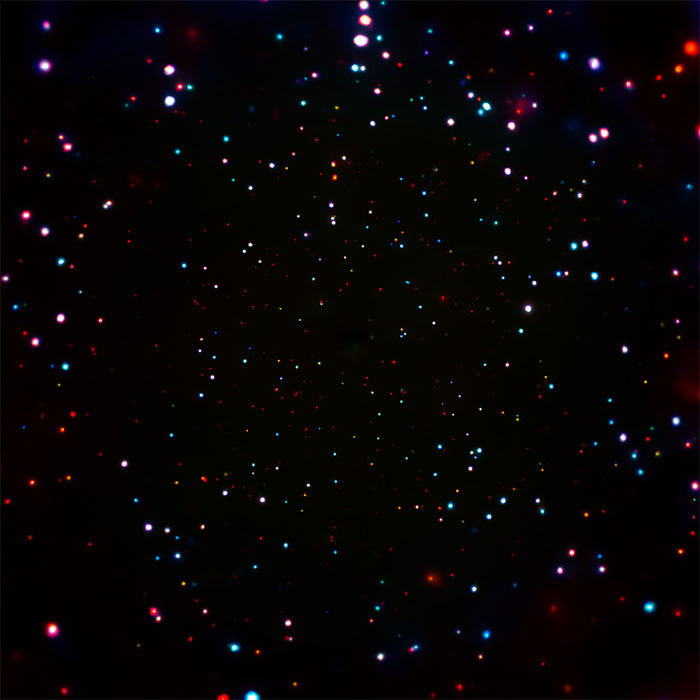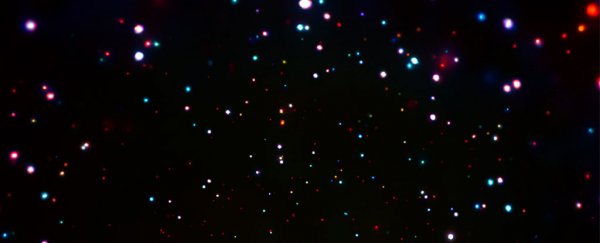Coming so soon after the festive period, you could be forgiven for thinking that the colourful, gleaming display above was a photo of somebody's Christmas lights – but what we're really looking at is something much more mind-boggling.
This picture, just released by NASA researchers, is actually the deepest X-ray image ever obtained, produced by the space agency's Chandra X-ray Observatory from an epic 11.5 weeks of observing time.
Yep, in a little under three months – or about 7 million seconds as NASA puts it – Chandra scientists trained the observatory's glare on a region of the night sky called the Chandra Deep Field South, which lies in the Fornax constellation.
This unique perspective means that those colourful twinkles aren't the stars visible to human eyes. The majority of those lights (70 percent) are actually supermassive black holes – or rather, they're the bright X-ray emissions produced as matter is pulled into a black hole's event horizon, as black holes themselves don't emit any light.
 NASA/CXC/Penn State/B.Luo et al.
NASA/CXC/Penn State/B.Luo et al.
Thanks to Chandra having gazed at this patch of sky for so long – in cumulative viewing sessions spread out over the course of some 17 years – NASA says the image offers the highest concentration of supermassive black holes ever seen: equivalent to about 5,000 of the objects fitting into the central region of the image, although only about 2,000 are depicted here.
And just to get a bit of perspective on how zoomed in this view of the Chandra Deep Field South is, everything you can see here would fit into a patch of the night sky no larger than the size of a Full Moon when viewed from Earth.
If you were to extrapolate, that means about a billion active galaxies – many with supermassive black holes at their centre – exist in the sky, although they're so distant from Earth, our ability to detect them means we're picking up the light shows they put on eons ago.
"It can be very difficult to detect black holes in the early Universe because they are so far away and they only produce radiation if they're actively pulling in matter," said one of the researchers, Bin Luo of Nanjing University in China.
"But by staring long enough with Chandra, we can find and study large numbers of growing black holes, some of which appear not long after the Big Bang."
In terms of the colours that we see here, red represents the lowest-energy X-rays, green is the medium band, and the highest-energy rays are the blue lights.
To make the image appear as it does, the researchers 'stacked' multiple exposures from Chandra and also used archival data from the Hubble telescope.
"While one exposure may only show a certain amount of light from an energetic event, a progressive number of exposures can build bigger and brighter pictures," John Wenz at Astronomy explains.
"Because events like this move on slow timescales (from a human observer point of view) stacking helps bring clarity to the data."
The supermassive black holes in the field of view would range in mass from about 100,000 to 10 billion times the mass of the Sun, and the researchers think they grew mostly in bursts in the era of the early Universe, rather than slowly accumulating matter.
The latest data also suggests that the solar masses that give rise to supermassive black holes – called 'seeds' – may contain more mass than scientists previously realised, starting off with masses between 10,000 to 100,000 times that of the Sun, rather than smaller objects with about 100 times the Sun's mass.
It will take more research to determine if that's actually the case, but the researchers think it could help explain how supermassive black holes like the ones captured here obtained so much mass so early in the Universe's existence.
So just how far back in time can Chandra see? In the case of this survey, the researchers studied about 2,000 galaxies at up to approximately 12.5 billion light-years from Earth, giving us a perspective on the cosmos relatively soon after the Big Bang, which is estimated to have occurred around 14 billion years ago.
"By detecting X-rays from such distant galaxies, we're learning more about the formation and evolution of stellar-mass and supermassive black holes in the early Universe," said one of the team, Fabio Vito from Pennsylvania State University.
"We're looking back to times when black holes were in crucial phases of growth, similar to hungry infants and adolescents."
The findings are reported in Monthly Notices of the Royal Astronomical Society and The Astrophysical Journal Supplement Series.
